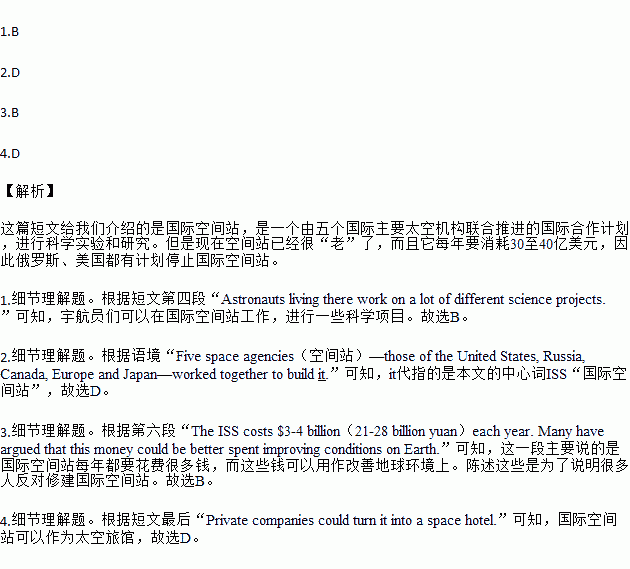题目内容
It is the second-brightest object in our night sky after the moon. It is one of man's greatest scientific achievements. It's the International Space Station(ISS)that orbits(绕……运行)Earth.
Nov. 20 marks the station's 20th birthday. In 1998, the first piece of the ISS was sent into space. Since then, 230 people from 18 countries have visited it.
Five space agencies(空间站)—those of the United States, Russia, Canada, Europe and Japan—worked together to build it. Weighing about 450 tons, it contains many different parts, including labs and solar panels(太阳能板)
Generally, the ISS holds three to six people at one time. Astronauts living there work on a lot of different science projects. The ISS has hosted over 1,500 such projects, according to NASA.
But the station is becoming older. In 2011, Russia announced that the ISS will not be used in 2020 in order to prevent it from becoming dangerous "space junk". But the US later said it would use repairs to make its service life longer(to 2025), the International Business Times reported.
The ISS costs $3-4 billion(21-28 billion yuan)each year. Many have argued that this money could be better spent improving conditions on Earth.
In February, US President Donald Trump announced plans to end support for the ISS by 2025.The US will use its money for other projects, like next-generation rockets and deep-space missions. The Washington Post reported.
What will happen to the ISS after 2025 is unknown. "There are lots of uses," former(前)astronaut Jeffrey Hoffman told NBC News. "Other ISS partners could continue scientific experiments on it. Private companies could turn it into a space hotel."
1.What do we know about the International Space Station?
A.It's the third-brightest object in our sky.
B.It's a spacecraft where astronauts can live and work.
C.Over 450 people have visited the ISS in the past 20 years.
D.It was built to provide solar energy for other spacecraft.
2.What does the underlined word 'it' refer to?
A.Solar panel. B.Space agency. C.Earth D.ISS.
3.What's the main idea of Paragraph6?
A.It's costly to keep the ISS running.
B.Most people were against building the ISS.
C.It was not necessary to build the ISS.
D.The ISS has nice living conditions.
4.What can we know from the passage?
A.No single country could have built the ISS by itself.
B.The US will stop exploring the space after 2025.
C.The ISS will become dangerous "space junk".
D.The ISS could be used as a hotel for space travelers.
 名师导航单元期末冲刺100分系列答案
名师导航单元期末冲刺100分系列答案 名校名卷单元同步训练测试题系列答案
名校名卷单元同步训练测试题系列答案
